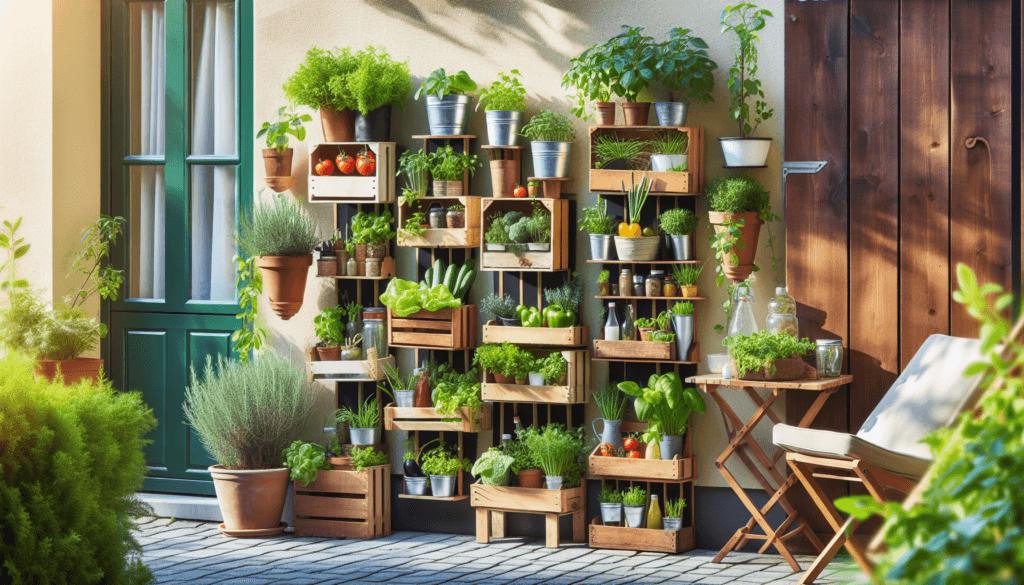Looking to start your own urban garden without breaking the bank? Look no further! In this article, we will explore a variety of frugal tips and tricks to help you create a thriving garden in the heart of the city, without draining your wallet. From clever DIY solutions to budget-friendly plant choices, we’ve got you covered. So grab your gardening gloves and let’s get started on transforming your urban space into a lush green oasis.

Choosing the Right Plants
When starting an urban garden on a budget, it’s important to choose the right plants that not only fit your budget but also thrive in your specific environment. By selecting low-cost plants, you can save money while still enjoying a beautiful garden. Look for nurseries or garden centers that offer discounts on plants or check online marketplaces for affordable options.
Opting for perennial plants is another great way to save money. Perennials are plants that come back year after year, reducing the need for frequent replacements. Not only do they save you money, but they also add beauty to your garden over an extended period. Some popular low-cost perennial options include coneflowers, daylilies, and black-eyed Susans.
Growing plants from seeds is an excellent way to save money and have a wide variety of plant options. Seeds are inexpensive and easily available in nurseries, garden centers, and online stores. You can start small by growing herbs or vegetables from seeds and expand your garden as you gain experience. Remember to follow the instructions on the seed packets and provide the necessary care for successful germination and growth.
Utilizing Small Spaces
In urban gardening, space is often limited. However, with some creativity, you can make the most of even the smallest areas.
Vertical gardening is an effective solution for maximizing space. By utilizing walls or fences, you can grow plants vertically, saving valuable ground space. Install trellises, wall-mounted planters, or hanging baskets to grow vine plants, such as tomatoes, cucumbers, or beans.
Window boxes and hanging planters are other space-saving options. They allow you to bring your garden to balconies, patios, or even small windowsills. Choose plants that thrive in these conditions, such as herbs, trailing flowers, or succulents, to add a touch of greenery to your urban space.
Using repurposed containers is not only budget-friendly but also environmentally friendly. Get creative and repurpose items like old buckets, wooden crates, or even mason jars as planters. With a bit of imagination, you can transform everyday objects into unique and charming containers for your plants.
DIY Compost and Fertilizers
Creating a compost bin is a cost-effective way to provide natural nutrients to your garden without spending extra money. Composting can be done in small urban spaces using a variety of methods, including traditional compost bins, worm composting, or bokashi composting. By composting your kitchen scraps, yard waste, and other organic materials, you create a nutrient-rich soil amendment that helps your plants thrive.
Making organic fertilizers at home is another frugal option. Whether it’s compost tea, seaweed fertilizer, or banana peel fertilizer, there are numerous DIY recipes available online. These homemade fertilizers provide essential nutrients to your plants while reducing the need for store-bought alternatives.
Using food scraps for composting is both economical and environmentally friendly. Instead of throwing away kitchen scraps like fruit peels, coffee grounds, or vegetable trimmings, turn them into valuable compost. By diverting these scraps from the landfill, you’re not only reducing waste but also creating nutrient-rich soil for your urban garden.
Water Conservation Methods
Water conservation is crucial, especially in urban areas where water may be limited or expensive. Implementing these methods in your garden will not only save water but also save you money.
Collecting rainwater is an excellent way to utilize nature’s gift and reduce your reliance on municipal water sources. Set up rain barrels or large containers to collect rainwater from your rooftop or gutters. Use this water to irrigate your garden during dry spells, reducing your water bill and promoting sustainability.
Using self-watering systems, such as drip irrigation or soaker hoses, can significantly reduce water usage. These systems deliver water directly to the roots of your plants, minimizing evaporation and ensuring efficient water distribution. Consider installing a timer to control the watering schedule and further optimize water usage.
Mulching is an effective technique to retain moisture in the soil. Apply a layer of organic mulch, such as wood chips, straw, or compost, around your plants. Mulch acts as a barrier, reducing evaporation and weed growth while keeping the soil consistently moist. This not only helps conserve water but also reduces the frequency of watering, saving you time and money.

Saving Money on Tools and Supplies
Gardening tools and supplies can quickly add up, but with some money-saving strategies, you can keep your budget intact.
Borrowing or sharing equipment with friends, family, or neighbors is a practical and cost-effective solution. Many gardening tools are not frequently used, so borrowing them when needed can save you from investing in expensive equipment. Additionally, you can organize tool-sharing programs within your community, creating a sense of camaraderie and reducing individual costs.
Shopping at thrift stores and yard sales is another great way to save money. Many people donate their unused gardening tools or supplies, providing you with affordable options. Check your local thrift stores or browse online platforms for secondhand garden tools, pots, or other essential supplies. You might be pleasantly surprised by the quality items you can find at a fraction of the original price.
Utilizing free or recycled materials is a sustainable and cost-effective approach. Look for discarded items like wooden pallets, cinder blocks, or old tires to repurpose into raised beds or unique planters. You can also collect fallen leaves, grass clippings, or coffee grounds from your neighborhood for composting or mulching, reducing the need to purchase these materials.
Organic Pest Control
Dealing with pests in your garden doesn’t have to mean reaching for expensive chemical sprays. There are several organic pest control methods that are both budget-friendly and environmentally conscious.
Homemade pest deterrents, such as garlic spray, chili pepper spray, or soap solution, can help keep pests at bay. These natural remedies can be made using ingredients from your kitchen pantry and are safe for your plants, pets, and the environment. Regularly apply these sprays to deter pests and maintain a healthy garden.
Companion planting is a natural pest control method that involves strategically placing plants together to repel harmful insects or attract beneficial ones. For example, planting marigolds alongside tomatoes can deter pests, while attracting ladybugs and other beneficial insects that feed on pests. Do some research to find out which plants have mutually beneficial relationships in your garden and make the most of this organic pest control technique.
Attracting beneficial insects is another way to naturally control pests. Plants like dill, fennel, or yarrow can attract beneficial insects such as ladybugs, lacewings, or parasitic wasps, which prey on common garden pests. By creating a welcoming environment for these insects, you can significantly reduce the need for chemical pesticides and promote a healthy ecosystem in your garden.

Growing Food from Kitchen Scraps
Don’t throw away those kitchen scraps! You can actually regrow many vegetables from scraps, reducing waste and saving money on buying new plants or seeds.
Regrowing vegetables from scraps is a fun and rewarding activity. Green onions, lettuce, celery, and even certain herbs can be regrown by placing the discarded ends in water or soil. With patience and care, you’ll soon have a fresh supply of homegrown produce without spending a dime.
Starting herbs from cuttings is another cost-effective method. Many herbs, such as basil, mint, or rosemary, can be propagated by taking cuttings from mature plants and placing them in water or soil. Within a few weeks, the cuttings will develop roots and grow into new plants, providing you with a constant supply of aromatic herbs.
Using leftover produce for new plants is not only a money-saving technique but also a way to appreciate the full potential of your groceries. Items like avocado pits, citrus seeds, or pepper seeds can be cleaned, planted, and nurtured to grow into new plants. It’s a fun and sustainable way to expand your garden while making the most of what you already have.
Community Gardening
Joining or starting a community garden is a fantastic way to enjoy gardening while sharing costs and resources with others. By working together, you can reduce individual expenses and create a vibrant green space for your community to enjoy.
Many cities have community gardens where individuals or groups can rent a plot of land to grow their own plants. These gardens provide a sense of community, shared knowledge, and shared expenses such as water and maintenance costs. It’s an opportunity to meet like-minded gardeners and learn from their experiences.
Sharing resources with neighbors is another way to cut costs and build relationships within your community. Consider organizing tool-sharing initiatives, where neighbors can borrow tools from one another as needed. You can also share seeds, compost, or even knowledge about successful gardening techniques. By working together, you can build a stronger and more sustainable community.
Participating in seed swaps is a fun and economical way to diversify your garden. Many gardening communities organize seed swap events where gardeners can exchange seeds they’ve collected or saved. It’s a great way to try out new plant varieties without spending money on new seeds. Additionally, seed swaps often include discussions and workshops, providing valuable information and fostering a sense of community among participants.

Saving Seeds for Future Planting
Saving seeds from your own garden not only saves you money but also allows you to grow and preserve unique varieties that may not be available commercially.
Choosing plants for saving seeds involves selecting open-pollinated or heirloom varieties. These plants produce seeds that can be saved and successfully germinated in subsequent years. Avoid hybrid plants, as their seeds may not produce plants true to the parent and may not offer the desired characteristics.
Harvesting and storing seeds properly is essential to maintain their viability. Allow the seeds to fully mature on the plant before harvesting. Remove the seeds, rinse off any pulp or debris, and lay them out to dry thoroughly. Store the seeds in a cool and dry place, such as an airtight container or envelope. Label the container with the plant name and date of harvesting for easy identification.
Trading seeds with other gardeners is a wonderful way to diversify your plant collection. Participate in seed swaps or connect with local gardeners to exchange seeds that you have saved. This not only expands your plant varieties but also strengthens the gardening community and fosters goodwill among fellow gardeners.
Maximizing Natural Light and Heat
Properly utilizing natural light and heat is essential for a successful urban garden on a budget.
Arranging plants for sunlight exposure is crucial to ensure they receive the right amount of light. Observe your garden throughout the day and determine which areas receive the most sunlight. Place sun-loving plants in these locations, while reserving shady spots for plants that thrive in lower light conditions. By understanding the sunlight patterns in your garden, you can optimize growth and avoid wasting money on plants that won’t thrive in particular areas.
Using reflective surfaces can increase the amount of light reaching your plants. Place reflective materials, such as aluminum foil or white paint, behind or around your plants to help bounce sunlight onto their leaves. This simple trick amplifies the effect of natural light, ensuring your plants receive as much brightness as possible.
Creating microclimate pockets can help maximize heat in cooler regions or extend the growing season in colder climates. Utilize heat-absorbing materials like rocks or bricks around your plants to collect and radiate warmth. Use protective covers like cloches or row covers to create small, sheltered areas that trap heat and protect delicate plants from cold temperatures. These strategies allow you to adapt and optimize your garden’s microclimate for the best possible growing conditions.
With these frugal tips and tricks, you can embark on your urban gardening journey without breaking the bank. By choosing the right plants, utilizing small spaces effectively, creating your own compost and fertilizers, conserving water, finding affordable tools and supplies, implementing organic pest control methods, growing food from kitchen scraps, participating in community gardening, saving seeds, and maximizing natural light and heat, you can create a thriving and budget-friendly garden in your urban oasis. Happy gardening!



